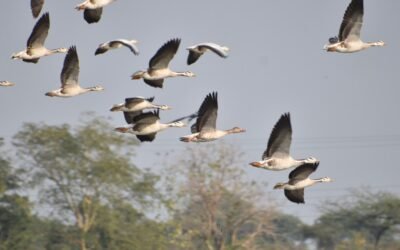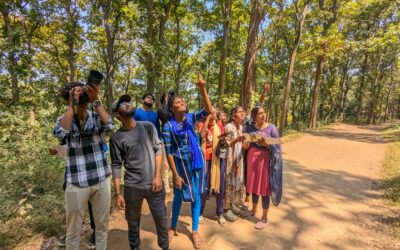Birdwatching for the Great Backyard Bird Count 2017, IISER
It was a warm morning on Saturday, the 18th of February 2017. Most of us would have been in bed, sleeping away the weariness accumulated over the long week of work—but on that morning, two ecologists, a biologist, a mathematician, a high- energy physicist, a Siberian Husky and bunch of excited undergraduates were awake.
Why?
To count birds of course.
The 20 scientists (and would- be scientists) from IISER Tirupati were part of the GBBC.
The Great Backyard Bird Count is an initiative by the Cornell Lab of Ornithology and National Audubon Society to encourage the citizens of the world to collect data about wild birds. It takes place over a span of 4 days, and in 2017, it was between the 17th and the 20th of February. About 160,000 people from over 130 countries counted more than 5600 species of birds.
Our troupe of amateur birdwatchers led by ecologists VV Robin and ecologist Nandini Rajamani went out to a plot of natural scrub forest in Yerpedu 30 km away from the temple city of Tirupati. We got there while the sun was still low in the sky. As soon as we deboarded the bus, we could immediately see and hear the rich diversity of birds. We could identify the loud black crows that sat on power lines that ran along the road, a flock of egrets flying over some trees in the distance, a kite flying way overhead, koels calling in the direction we planned to go. For those birds that we couldn’t immediately identify, we used the binoculars and bird books we were all readily armed with.
We decided to split up into two groups, circle a rather small patch of scrub forest, and meet on the other side. I was in the group that went east. We stalked the birds behind bushes and trees, trying ever so hard to get a better view. We worked as a team, with some of us looking at a bird and whispering what they saw, some of us matching the features with names of birds in the books, some of us updating it on eBird, and some of us helping guide the people who weren’t paying attention to the exact location of the bird in the bush.
We first encountered a strange little bird that was flying vertically up and down over a little area, chirping while doing so. It was a bushlark. It’s peculiar flight pattern was a little dance it did to attract mates, or to stake its territory, or both. As we moved onward we saw a bunch of red- vented bulbuls, a tree with about 7 black drongos on it, a barn swallow too. Some birds were harder to see, like the Indian robin, Eurasian collared dove, spotted dove and the Indian roller. We saw an uncommon bird too—a Jerdon’s bushlark.
I guess the most exciting part was the “wild goose chase”. Someone spotted a rather large bird. At first glance, it looked purple. That was all we could see before it decided to fly away to a grove of mango trees there. We were all running frantically behind it, trying to direct each other’s gaze toward this almost mystical bird. All of us assumed different positions on the ground, spread out in a circle around it. We were so close. But it was all in vain, the bird was too fast, the mango leaves too many, our legs not agile and our eyes strained. It got away. I guess that which is most beautiful dislikes being seen. It was okay, the many mangoes that we plucked weighed our bags down and lifted our spirits again.
We came back to the institute, after about two hours of birding. We all ate breakfast together at one table talking about all the birds we saw—a total of 14 species—and the things we went through to see them. Birding brought us all together and taught us so much. We all left the canteen with great stories to tell and experiences and knowledge to share. We felt accomplished and proud for being a part of a worldwide initiative to go out and see our feathered friends who live closer to us that we realize.
As far as me and my undergrad buddies were concerned, and I’m sure they’ll agree with me when I say, it was definitely a great way to spend a Saturday morning.
– N S Chiranjeevi (Student, IISER Tirupati)




Good Work Parvez and others who helped him.
bird counting is very useful to youngster those who are not watching the nature. because of bird counting youngster watch the nature
nice read Harman…..
Congratulations!